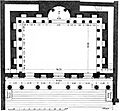Library of Celsus facts for kids
The Library of Celsus is a very old Roman building in a city called Ephesus. Today, Ephesus is in Turkey, which is part of Anatolia. This amazing library was built to honor a powerful Roman leader named Tiberius Julius Celsus Polemaeanus, often just called Celsus.
Celsus was a very important person. He was a Consul (a top government official) in 92 AD and later the Governor of the Roman province of Asia in 115 AD. He was also a wealthy and popular citizen from a nearby city called Sardis. Celsus was one of the first Greek men to become a consul in the huge Roman Empire. The library honors him as both a Greek and a Roman.
Celsus paid for the library's construction using his own money. His son, Gaius Julius Aquila, who was also a Consul in 110 AD, finished building it in 135 AD.
The library was designed to hold about 12,000 scrolls, which were like books back then. It also served as a special tomb for Celsus. He is buried in a sarcophagus (a stone coffin) right beneath the main entrance of the library. Being buried inside a library or even within city limits was very unusual, so this was a great honor for Celsus.
Contents
History of the Celsus Library
The Library of Celsus was built in Ephesus, which was an important Greek city in Asia Minor. This building is very important because it is one of the few ancient Roman libraries that still exists today. It also shows that public libraries were built not just in Rome itself, but all across the vast Roman Empire.
Destruction and Restoration
Sadly, the inside of the library and all its scrolls were destroyed by a big fire. This fire happened during a terrible earthquake that hit the city in 262 AD. Only the front part, called the facade, survived. Around 400 AD, the library building was used for other purposes. The facade itself was completely destroyed by another earthquake much later, probably during the late Byzantine period.
In the 1960s and 1970s, the beautiful facade was carefully put back together. Now, it stands as a fantastic example of ancient Roman public architecture. The building had one main hall that faced east. This was done on purpose to catch the morning sun, which was good for people who liked to read early.
Architectural Design
The front of the library has four pairs of Ionic columns standing on pedestals. Right above these, there is another set of Corinthian columns, making the building look even taller. Some historians believe there might have been a third set of columns even higher up.
This style of facade, with its special frames and niches (small alcoves) for statues, looks a lot like the fronts of ancient Greek theatres. Because of this, it is sometimes called "scenographic," meaning it looks like a stage set.
Images for kids
-
A marble statue of Celsus, which stood in the central niche of the upper storey of the Celsus Library. It is now in the Istanbul Archaeological Museum
-
Personification of virtue (Greek ἀρετή) in the Celsus Library
See also
 In Spanish: Biblioteca de Celso para niños
In Spanish: Biblioteca de Celso para niños






